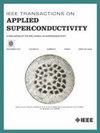线性加速器用导冷可裂超导磁体的设计与试验
IF 1.8
3区 物理与天体物理
Q3 ENGINEERING, ELECTRICAL & ELECTRONIC
引用次数: 0
摘要
大连先进光源光束测试平台需要在低温模块的末端安装一个超导四极磁铁(带有X/Y校正线圈)来聚焦光束。该四极磁体孔径为81 mm,场梯度为8 T/m, X/Y积分校正场为67 Gs-m,磁长为0.23 m。中心±15 mm范围内的四极场不均匀性控制在0.1%以内,距腔端10 cm处泄漏场小于5 mg。考虑到磁场性能、成本效益和可靠性,我们选择了铁芯结构的传导冷却赛道线圈,使四极和X/Y校正线圈共享一个共同的极结构。此外,由于SCRF空腔必须安装在清洁环境中,因此磁体设计为垂直分裂结构,允许在SCRF空腔串安装在洁净室后组装在低温模块中。本文介绍了超导四极磁体的磁场设计、机械结构、热分析、淬火保护和制造。最后,在低温液氦浴中对磁体进行了测试,详细测量了磁场分布。本文章由计算机程序翻译,如有差异,请以英文原文为准。
Design and Testing of Conduction-Cooled Splitable Superconducting Magnet for Linear Accelerators
The Dalian Advanced Light Source Beam Testing Platform requires a superconducting quadrupole magnet (with X/Y correction coils) to be installed at the end of the cryomodule to focus the beam. This quadrupole magnet has an aperture of 81 mm, a field gradient of 8 T/m, an integrated X/Y correction field of 67 Gs-m, and a magnetic length of 0.23 m. The nonuniformity of the quadrupole field within ±15 mm of the center is controlled to 0.1%, with a leakage field below 5 mGs at 10 cm from the cavity end. Considering magnetic field performance, cost-efficiency, and reliability, a conduction-cooled racetrack coil with an iron core structure was chosen, enabling the quadrupole and X/Y correction coils to share a common pole structure. Furthermore, since the SCRF cavities must be installed in a clean environment, the magnet is designed with a vertically split structure, allowing for assembly in the cryomodule after the SCRF cavity string has been installed in the clean room. This article presents the magnetic field design, mechanical structure, thermal analysis, quench protection, and manufacturing of the superconducting quadrupole magnet. Finally, the magnet was tested in a cryogenic liquid helium bath, with detailed measurements of the magnetic field distribution.
求助全文
通过发布文献求助,成功后即可免费获取论文全文。
去求助
来源期刊

IEEE Transactions on Applied Superconductivity
工程技术-工程:电子与电气
CiteScore
3.50
自引率
33.30%
发文量
650
审稿时长
2.3 months
期刊介绍:
IEEE Transactions on Applied Superconductivity (TAS) contains articles on the applications of superconductivity and other relevant technology. Electronic applications include analog and digital circuits employing thin films and active devices such as Josephson junctions. Large scale applications include magnets for power applications such as motors and generators, for magnetic resonance, for accelerators, and cable applications such as power transmission.
 求助内容:
求助内容: 应助结果提醒方式:
应助结果提醒方式:


